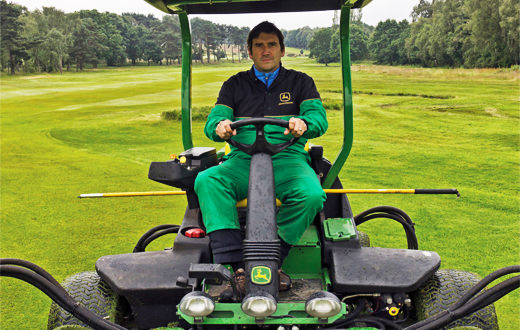
A day in the life of a golf course greenkeeper
The last time I was up at 5am I was in no fit state to operate heavy machinery. Now I am trundling across the M62 on my way to Moortown to spend a day, albeit not my usual 10-6 one, as a greenkeeper.
My CV for this particular task was almost blank other than the occasional lawn mowing which, given the size of my front garden, can normally be completed in under 10 minutes.
Otherwise I can easily turn my hand to a spot of strimming but then struggle a bit when the twine runs out.
I meet the course manager Steve Robinson at 6.45am and he escorts me to the greenkeeping headquarters behind the 15th green. I wait for the offer of a cup of tea.
Within 20 minutes seven greenkeepers and a gardener have arrived and disappeared off on mowers to get 18 holes moved (plus the nine on the putting green), every bunker smoothed over and the whole course cut ahead of the weekend.
Ideally this would take place a lot earlier but, given the proximity of the local houses, noise pollution prevents it from happening.
All this is planned days in advance and everything is reliant on the weather. We all obsess about the weather, mainly because it’s miserable, but Steve has to obsess a little further.
Inside the Ropes: The Life of an Augusta Greenkeeper
He will check the weather last thing at night, first thing in the morning and his first task is to check the rain gauge, which is perched on an old 7 iron, before he has even got out of the car.
After that he will look at the weather websites to see if what is in the rain gauge tallies with the forecast.
Roughly speaking if there was 4mm everything could carry on as planned, 8mm might compromise a task, no mowers would be allowed at 12mm and, at 25mm, that would signal the end of your buggy or trolley for the day and they would think about closing the course.
Both say no rain today. Steve appears to relax a little and leaves a voicemail message for the members that the course is open.
Greenkeeping Q&A: Your questions answered
After that Steve has a 15-minute walk around the course to determine any disease or stress and, here we go again, how any rain has affected things.
Given my lack of expertise my first task is to operate something called a switching cane. You will have seen your greenkeepers wave these effortlessly around to remove worm casts and excess grass from tees or greens (and their surrounds) before and after cutting.
Needless to say I only dipped my toe in the water here as the vast majority of the work needs years of practice and qualifications Steve watches me miss large chunks of the ground before I slowly get the hang of it and only miss small parts. It takes at least twice as long as it should do and, even then, requires a late tidy.
We move on to bunkers where I can do little damage and it is here where Moortown has made great strides in recent years. Architect Ken Moodie used a 1948 aerial photograph taken by the RAF to determine where the original Dr Alister MacKenzie bunkers were and what shape they were.
Moortown Golf Club: A brilliant Alister MacKenzie heathland design
After the war a lot of the bunkers were filled in to save on money and maintenance but they have now been restored to their stunning best. In the last four years the course has gone from 66 to 91 traps – and they all need raking.
Thankfully I stop after one hole (and six bunkers) as it is time to cut a new hole on the 18th green.
We make our way down the final hole and it slowly begins to chuck it down. The unpredictability of the British weather strikes again and the best laid plans slowly unravel. Except the jobs have to be finished.
The general rule of thumb is to have six hard, six average and six easy pin positions but, with an invitation day the following day, the emphasis is on more of the easy variety.
When cutting a hole you should avoid old holes, be a certain distance from the edge of the green and not be on more than a 5Ëš slope. Having watched Steve’s assistant Kevin quickly work his way around the putting green it seemed another skill that would quickly be mastered. Or not.
Greenkeepers’ Question Time: Your queries answered
This is a very precise task and thankfully, with Kevin’s help, the pin finally sat square and was even still in place when I drove out of the car park two hours later.
Needless to say I only dipped my toe in the water here as the vast majority of the work needs years of practice and qualifications. It also requires a huge amount of planning and record taking.
For example, to spray pesticides you need to look at the predicted wind speeds as it can cost up to £700 to try and combat one particular problem so you don’t want it blowing off into someone’s back garden.
Then you need to note what chemicals have gone down as that affects the agronomy – there are many different grasses on a course so if you are trying to promote certain ones it is imperative you get fertilising and watering right.
The real eye opener was the time constraints and efforts that go in to making your course look so presentable.
If someone has been mowing for three hours he will be relieved out on the course rather than bring the mower back to base to swap over.
Greenkeeping Diaries: A day in the life of a greenkeeper
Then there is all the work that goes on underground, the pipes and drainage that you will never see but still has to be maintained and managed.
The course is the real star of your club, not the snooker room or the new grill, and the likes of Steve and his team make sure that that remains the case.
“I have a genuine passion in golf course presentation,” he says.
“The involvement is massive – you sit there on holiday wondering how the course is.
“The better greenkeepers love being at work. I have friends who dread work on a Sunday afternoon but I have never had that.”












